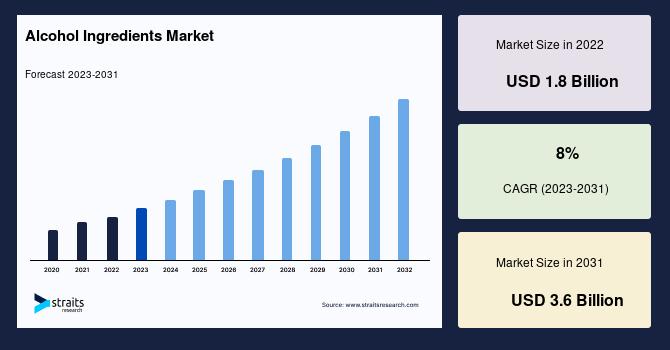Alcohol Ingredients Market: A Catalyst for Growth and Innovation in the Beverage Industry

The global alcohol ingredients market is witnessing remarkable growth, driven by rising demand for premium and craft alcoholic beverages, evolving consumer tastes, and advances in production technologies.
Valued at approximately USD 1.8 billion in 2022, the market is poised to double by 2031, with projections estimating a value of USD 3.6 billion, growing at a strong compound annual growth rate (CAGR) of around 8% over the forecast period. This dynamic market plays a crucial role in shaping beverage quality, flavor profiles, and production efficiency across various alcoholic drink categories.
Market Overview and Growth Drivers
Alcohol ingredients encompass a diverse array of raw materials and additives essential to the production of beer, spirits, wine, and other alcoholic beverages. Core components include yeast, enzymes, colorants, flavors, salts, and malt, each contributing uniquely to the fermentation process, flavor development, visual appeal, and shelf life of the final products. Among these, malt ingredients dominate the sector due to their critical role in supplying fermentable sugars and carbohydrates that define the characteristic alcohol content and taste in beverages like beer and whiskey.
The burgeoning popularity of craft brewing and artisanal distilling has been a significant catalyst for market expansion. Consumers today seek innovative, authentic, and richly flavored drinks that deviate from mass-produced options. This shift has fostered a rise in specialty malts, exotic flavorings, and novel infusions that elevate the sensory experience. Craft beer enthusiasts, for example, favor unique malt blends, hops varieties, and inventive additives, pushing producers to diversify ingredient portfolios continuously.
Technological advancements in fermentation and distillation processes also contribute to enhanced product quality and production efficiency. Enzymes help optimize biochemical reactions during fermentation, enabling higher yields and more consistent results while facilitating the use of local, cost-effective raw materials. Additionally, ingredient innovations like caramel syrups and powders improve the aesthetic characteristics such as color and brightness in spirits and liquors, further appealing to consumer preferences.
Regional Market Insights
Europe holds the largest share in the global alcohol ingredients market, driven by its long-established beverage industry and high consumer demand for premium and craft products. In countries like the UK, the rising enthusiasm for distinct flavors and novel alcoholic drinks fuels demand for advanced ingredients, especially colorants, flavorings, and malt sourced from domestic barley farmers.
The Asia-Pacific region is emerging as the fastest-growing market, energized by changing cultural attitudes, urbanization, and increasing disposable incomes. Traditional grain-based alcohol forms, such as China’s baijiu, benefit from rising production capacity and expanding distribution channels. The growth of microbreweries and craft distilleries in this region further elevates ingredient demand, particularly for specialty fermentation agents and diverse flavor profiles.
North America demonstrates steady growth, propelled by innovation, consumer interest in premium and flavored beverages, and a vibrant craft beer scene. In particular, the proliferation of artisan distilleries producing unique liqueurs and spirits ranging from vodka and gin to brandies has boosted the market. Similarly, Latin America, the Middle East, and Africa are experiencing expanding consumption driven by improving economies, shifting demographics, and social trends promoting alcohol usage.
Ingredient Types and Beverage Applications
Yeast remains an indispensable ingredient, facilitating fermentation across nearly all alcohol types. Varieties such as ale yeast and lager yeast, along with their specific strains, enable brewers to craft distinctive beverage styles. Enzymes enhance fermentation efficiency, accelerate maturation, and improve product consistency.
Flavorings and colorants are essential in differentiating products in a highly competitive market. As consumer palates evolve, demand grows for exotic and intricate tastes combining fruit extracts, spices, and botanical infusions. Caramel colors are particularly critical in spirits to ensure vibrant, stable hues that meet brand identity standards.
When segmented by beverage type, beer leads with the highest consumption of alcohol ingredients. The rapid growth of craft brewing and microbrewery establishments globally drives demand for specialty malt, hops, and yeast blends. Meanwhile, spirits such as whiskey and brandy are gaining momentum due to consumer interest in premiumization, novel flavor experiences, and cocktail culture. These segments are supported by specialized malt extracts, caramelized sugars, and flavor enhancers tailored to distinct taste profiles.
Challenges and Opportunities
Despite promising prospects, the alcohol ingredients market faces certain challenges. The fluctuating costs and uneven supply of raw materials, including malted barley and adjuncts like maize and rice, can impact production stability and profitability. Climate change poses risks to the cultivation of essential crops used in alcohol production, prompting concern among industry stakeholders.
Nevertheless, these challenges spur innovation. Ingredient producers are investing in sustainable sourcing, advanced fermentation technologies, and novel formulations to meet health-conscious and eco-aware consumer demands. The increasing preference for low-alcohol and alcohol-free beverages opens fresh avenues for natural sweeteners, fermentation enhancers, and flavor mimetics that retain alcoholic taste while reducing alcohol content.
Future Outlook
The alcohol ingredients market is set for sustained growth, bolstered by rising global alcohol consumption, preference for craft and premium beverages, and continuous product innovation. The expanding hospitality sector, including bars, pubs, and restaurants, along with supportive government initiatives promoting craft beverage production, provides fertile ground for market expansion.
Emerging trends such as the integration of plant-based ingredients, exploration of new fruit and botanical infusions, and advances in bioengineering of yeast and enzymes promise to redefine market dynamics. Companies adapting swiftly to consumer preferences for authenticity, taste diversity, and sustainable production will capture increasing market share.
In summary, the alcohol ingredients market embodies a dynamic intersection of tradition and innovation, where timeless fermentation practices meet cutting-edge scientific advancements. This integration ensures the continuing evolution of the global beverage industry, satisfying consumers’ desire for quality, variety, and distinctive experiences for years to come.
- Art
- Causes
- Crafts
- Dance
- Drinks
- Film
- Fitness
- Food
- Games
- Gardening
- Health
- Home
- Literature
- Music
- Networking
- Other
- Party
- Religion
- Shopping
- Sports
- Theater
- Wellness


